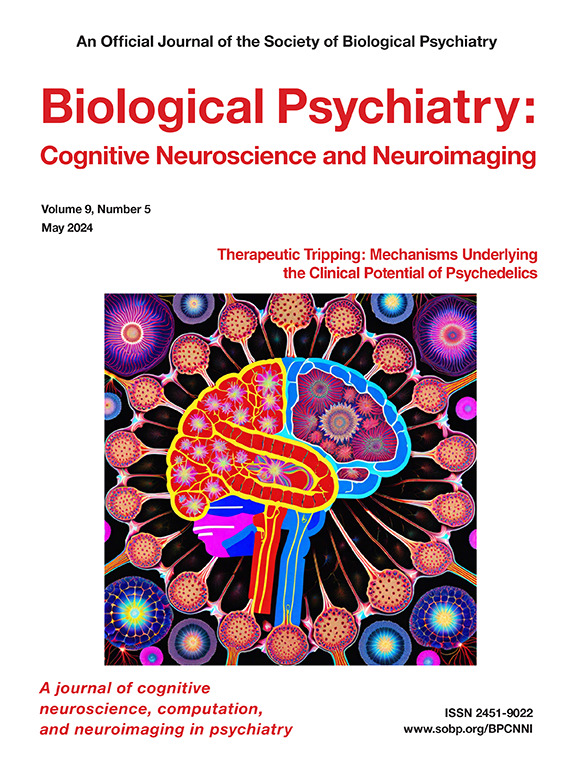根据整体皮层厚度调整区域皮层厚度测量结果会掩盖整个精神分裂症谱系的缺陷:关于脑成像数据规范建模的警示》。
IF 4.8
2区 医学
Q1 NEUROSCIENCES
Biological Psychiatry-Cognitive Neuroscience and Neuroimaging
Pub Date : 2025-06-01
DOI:10.1016/j.bpsc.2024.06.001
引用次数: 0
摘要
最近的神经影像学研究和公开发布的分析工具都主张区域形态计量分析与整体厚度协整。我们通过经验证明,这种统计方法严重低估了精神疾病的区域厚度畸形。研究 1 包括 90 名健康对照者、51 名临床高危精神病患者和 78 名早期精神分裂症患者。研究 2 包括 56 名健康对照者、83 名非情感性精神病患者和 30 名情感性精神病患者。我们研究了总体和区域厚度相关性、总体厚度组间差异以及有/无总体厚度协变的区域厚度组间差异。总体厚度和区域厚度在各组之间具有很强的相关性。精神分裂症谱系组的整体厚度低于其他组。精神分裂症谱系组的区域厚度缺陷在全局厚度协变的情况下会减弱/消除。剥夺区域厚度与整体厚度的共同方差可消除疾病相关效应。这种统计方法会导致错误的结论,即区域厚度在精神分裂症或临床高危综合征等疾病中是正常的。本文章由计算机程序翻译,如有差异,请以英文原文为准。
Adjustment of Regional Cortical Thickness Measures for Global Cortical Thickness Obscures Deficits Across the Schizophrenia Spectrum: A Cautionary Note About Normative Modeling of Brain Imaging Data
Recent neuroimaging studies and publicly disseminated analytic tools suggest that regional morphometric analyses covary for global thickness. We empirically demonstrated that this statistical approach severely underestimates regional thickness dysmorphology in psychiatric disorders. Study 1 included 90 healthy control participants, 51 participants at clinical high risk for psychosis, and 78 participants with early-illness schizophrenia. Study 2 included 56 healthy control participants, 83 participants with nonaffective psychosis, and 30 participants with affective psychosis. We examined global and regional thickness correlations, global thickness group differences, and regional thickness group differences with and without global thickness covariation. Global and regional thickness were strongly correlated across groups. Global thickness was lower in the schizophrenia spectrum groups than the other groups. Regional thickness deficits in schizophrenia spectrum groups were attenuated or eliminated with global thickness covariation. Eliminating the variation that regional thickness shares with global thickness eliminated disease-related effects. This statistical approach results in erroneous conclusions that regional thickness is normal in disorders like schizophrenia or clinical high risk syndrome.
求助全文
通过发布文献求助,成功后即可免费获取论文全文。
去求助
来源期刊

Biological Psychiatry-Cognitive Neuroscience and Neuroimaging
Neuroscience-Biological Psychiatry
CiteScore
10.40
自引率
1.70%
发文量
247
审稿时长
30 days
期刊介绍:
Biological Psychiatry: Cognitive Neuroscience and Neuroimaging is an official journal of the Society for Biological Psychiatry, whose purpose is to promote excellence in scientific research and education in fields that investigate the nature, causes, mechanisms, and treatments of disorders of thought, emotion, or behavior. In accord with this mission, this peer-reviewed, rapid-publication, international journal focuses on studies using the tools and constructs of cognitive neuroscience, including the full range of non-invasive neuroimaging and human extra- and intracranial physiological recording methodologies. It publishes both basic and clinical studies, including those that incorporate genetic data, pharmacological challenges, and computational modeling approaches. The journal publishes novel results of original research which represent an important new lead or significant impact on the field. Reviews and commentaries that focus on topics of current research and interest are also encouraged.
 求助内容:
求助内容: 应助结果提醒方式:
应助结果提醒方式:


